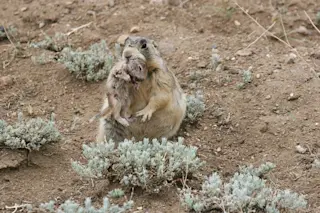Prairie dog lovers got a shock last week when researchers discovered that the cuddly burrowers had a mean streak.
Multiple white-tailed prairie dogs in western Colorado were observed chasing down and killing ground squirrels in the vicinity of their dens, ripping into them with their jaws and shaking them from side to side with enough force to snap their necks. This behavior was initially surprising, because prairie dogs are herbivores — peaceful plant eaters, right? Far from it. After killing their prey, the prairie dogs left their victims to rot under the sun. Occasionally, they’d pick at their chest or brains to ensure they were dead.
But they aren’t the only vegetarians in the animal kingdom to break bad.
Much of the surprise at prairie dogs’ vicious behavior stems from a mistake commonly made when observing animals: assigning human traits and values to critters. It’s heartwarming to see videos of ...














